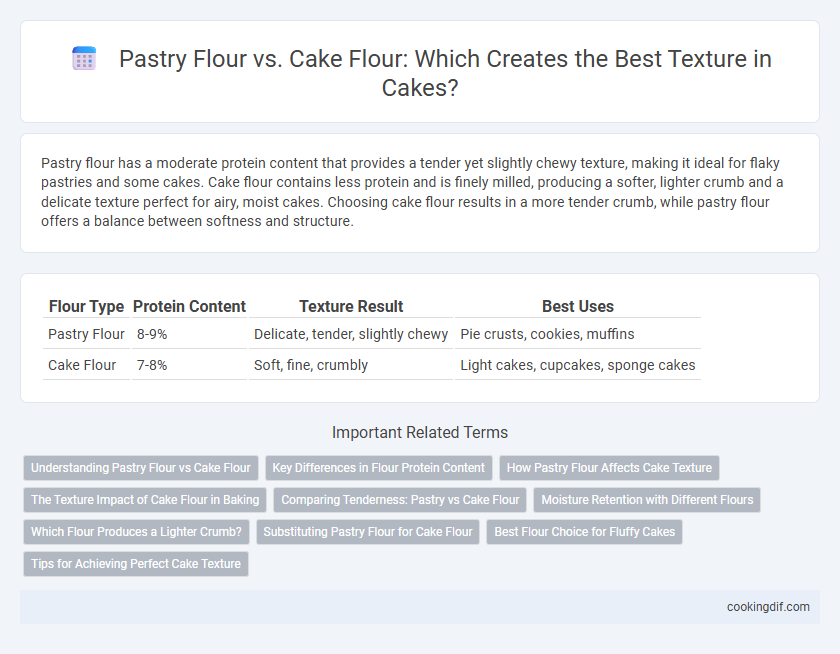Pastry flour has a moderate protein content that provides a tender yet slightly chewy texture, making it ideal for flaky pastries and some cakes. Cake flour contains less protein and is finely milled, producing a softer, lighter crumb and a delicate texture perfect for airy, moist cakes. Choosing cake flour results in a more tender crumb, while pastry flour offers a balance between softness and structure.
Table of Comparison
| Flour Type | Protein Content | Texture Result | Best Uses |
|---|---|---|---|
| Pastry Flour | 8-9% | Delicate, tender, slightly chewy | Pie crusts, cookies, muffins |
| Cake Flour | 7-8% | Soft, fine, crumbly | Light cakes, cupcakes, sponge cakes |
Understanding Pastry Flour vs Cake Flour
Pastry flour has a protein content of about 8-9%, offering a tender and crumbly texture ideal for pie crusts and biscuits, while cake flour contains around 7-8% protein, resulting in a finer, softer crumb perfect for delicate cakes. The lower gluten development in cake flour produces a light, airy texture, whereas pastry flour's slightly higher gluten contributes to a flakier, sturdier product. Choosing between pastry flour and cake flour depends on the desired cake texture, with pastry flour providing more structure and cake flour ensuring maximum softness.
Key Differences in Flour Protein Content
Pastry flour contains 8-9% protein, which provides more gluten formation and results in a tender yet slightly chewy texture, ideal for pie crusts and tarts. Cake flour has a lower protein content, around 6-7%, producing less gluten for a softer, finer crumb in cakes and delicate baked goods. The reduced protein in cake flour creates a lighter, fluffier texture, while pastry flour strikes a balance between tenderness and structural integrity.
How Pastry Flour Affects Cake Texture
Pastry flour, with a protein content of around 8-9%, strikes a balance between tenderness and structure, producing cakes with a slightly coarser crumb compared to the ultra-soft texture from cake flour. Its moderate gluten formation results in cakes that are moist and tender but with a bit more density and chewiness than the light, airy texture achieved with low-protein cake flour. Using pastry flour can enhance the cake's ability to hold shape while maintaining softness, ideal for recipes requiring a firmer yet tender crumb.
The Texture Impact of Cake Flour in Baking
Cake flour, with its lower protein content (7-9%), produces a finer, softer crumb compared to pastry flour, which typically has a protein content of around 8-9%. The reduced protein level in cake flour limits gluten formation, resulting in tender, delicate textures ideal for cakes. Pastry flour offers a slightly stronger structure due to more gluten development, making cake flour the preferred choice for achieving light, airy baked goods.
Comparing Tenderness: Pastry vs Cake Flour
Cake flour produces a softer, finer crumb due to its lower protein content, which creates less gluten and results in a more delicate texture. Pastry flour has a slightly higher protein level, providing a balance between tenderness and structure, making it ideal for flaky pastries. When comparing tenderness, cake flour yields a more tender, melt-in-the-mouth finish, while pastry flour offers a slightly denser but still tender bite.
Moisture Retention with Different Flours
Pastry flour contains moderate protein levels, which balance gluten development and moisture retention, resulting in tender yet slightly denser cakes compared to cake flour. Cake flour, with its lower protein content and finer milling, absorbs less water, enhancing moisture retention and producing lighter, softer cake textures. Choosing cake flour maximizes moisture retention for delicate crumb structures, while pastry flour offers a moister, richer bite due to higher water absorption and gluten interaction.
Which Flour Produces a Lighter Crumb?
Cake flour produces a lighter crumb compared to pastry flour due to its lower protein content, typically around 7-8%, which results in less gluten formation. Pastry flour has a slightly higher protein content, around 8-9%, creating a denser texture ideal for tender yet flaky pastries rather than ultra-soft cakes. Using cake flour ensures a delicate, airy texture perfect for light cakes and sponges.
Substituting Pastry Flour for Cake Flour
Pastry flour offers a slightly higher protein content than cake flour, resulting in a denser and chewier texture when substituted. Using pastry flour instead of cake flour can produce cakes with less tenderness and a firmer crumb due to its gluten structure. For recipes requiring delicate, airy textures, adjusting the flour ratio or incorporating cornstarch may be necessary to mimic cake flour's softness.
Best Flour Choice for Fluffy Cakes
Cake flour, with its lower protein content (7-8%), produces a tender, airy crumb ideal for fluffy cakes, while pastry flour, containing slightly more protein (8-9%), yields a denser, chewier texture better suited for pastries. Using cake flour enhances cake volume and softness by minimizing gluten development, resulting in a light and delicate texture. For achieving the fluffiest cakes, cake flour remains the best flour choice due to its fine texture and ability to absorb more liquid, contributing to moistness and lift.
Tips for Achieving Perfect Cake Texture
Pastry flour contains more protein than cake flour, contributing to a slightly denser yet tender crumb, ideal for pie crusts and pastries requiring a flaky texture. Cake flour, with its lower protein content and finer grind, produces a softer, airier texture perfect for light, delicate cakes. For achieving perfect cake texture, sift cake flour thoroughly, measure accurately, and avoid overmixing to maintain a tender crumb.
Pastry flour vs Cake flour for texture Infographic

 cookingdif.com
cookingdif.com